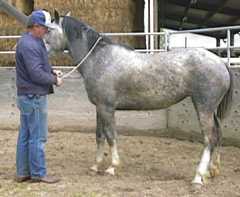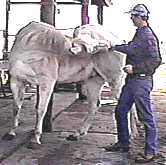|
Here are a few terms that we use and their definitions.
- Clicker
A device, also known as a "cricket," which makes a
loud, distinctive clicking noise when pressed.
- Click
The sound you make with the clicker to
mark the instant the horse has achieved the
desired behavior
- Reward
A treat or other positive feedback, such as a nice
scratch, after the click is sounded. Food rewards
are generally used until the horse solidly understands
the game
- Stress-feedback loop
An emotional condition where the horse's stress is
building based on his own anxiety. An example could
be a saddle pad placed on the horse's back for the
first time. The pad is quietly resting there but the
horse's stress continues to build until he reacts.
Typically these would be situations where in the wild,
the stress would build up until the horse takes flight.
Other situations where stress-feedback loops occur include
being held in the chute, the first time at the tie pole
and having legs held for farriery work.
- Scattered / scattering
A condition where the horse is not staying focused on
anything in particular, but is randomly responding (reacting)
to any of a number of environmental stimuli
- Hug-A-Spook
A scattered horse who doesn't pay attention to his
environment, then spooks when he notices things and
wants to jump into your lap.
- Mugging
What a horse does to you when he has an uncontrolled
desire for goodies. Discipline on the part of the handler
will soon teach the horse that treats don't come without
clicks so his mind will be on his work, not on getting to
your pocket or pouch full of carrots.
- Targeting / Click-targeting
Getting the horse to focus on an object, typically
by using "Touch it!" or a similar game.
- Focus Training
Directing the horse's attention to the handler or
a specific objective, often through use of targeting.
- Stress Interruption or "Click-assurance"
Interrupting the stress-feedback loop and reassuring
the horse that the engagement isn't fundamentally
harmful or negative and that the horse can elicit
some positive results (a reward). We'll often have
the horse target a familiar object for this purpose.
- Game / Clicker Game
A scenario that the handler sets up where the horse
tries to earn a reward by figuring out the behavior
that the handler is asking for.
- Click Reinforcement
Going back over a familiar behavior using click-reward
when the horse gets unsteady with a behavior or is
just generally in an unsure state of mind.
- "Touch it!"
One of our basic games where we present a target and
ask the horse to touch it with his nose. Whiskers
count the first few times, then the horse has to
bump it, then we make the target harder to reach, even
eventually throwing it so the horse has to walk over to it to
earn the click.
- "Walk up!"
A basic game where the horse learns to walk to the
handler on command.
- "Stand still!"
A game where the horse stands in a relaxed frame regardless
of what is going on. This game has to be reinforced as
necessary through repetition depending on the anxiety
created by the circumstances (e.g., being examined by the
vet.)
- Whoa!
This game should be self explanatory. We generally use
traditional natural horsemanship moves to show the horse
what we want. "Whoa!" comes in handy when first catching
your horse in the arena or if he gets loose, in conjunction
with "Walk up" for him to approach you and "Stand still" to
be haltered.
- "Pick up!"
Lifting a particular foot which is touched by the handler.
This game increases in difficulty until the horse will hold
the foot or lightly rest it on the handler's hand or leg
for as long as it is being touched.
Again, you can generate your own games and verbal cues.
Be sensible, keep them simple at first and be consistent in
their application.
|
Here are some links to a few other good clicker sites to get you started:
-
ClickRyder
The host site for the "ClickRyder" web ring.
-
Clicker Training for your Horse
Alexandra Kurland's clicker training website.
(Note: Alex's book was the only written reference
that we had when we started the case study horses.)
-
ClickerTrain.Com
A complete website with tips, case studies,
sources for supplies and many links.
|
|
|
CLICKER BOOKS AND BOOKLETS
|
|
Haltering a wild horse
with a Progress String
Until Keno got solid at haltering, I made a little neck
loop with the progress string to provide just a
little guidance for her head while haltering.
First we play "Touch it!"
with the progress string

Next I touch her shoulder
with the string and we
play "Stand still!"

Next I pass the string
over her neck and pass the
strings's tail through the eye

Then I introduce the halter

Then we play "Touch it!"
and slip the halter on

And Keno is haltered and
more importantly, relaxed

Straight Haltering
Once Keno could be haltered without a progress string,
here is the procedure we followed.
First we play "Touch it!"
with the halter

Next I touch her neck
with the halter

Next I touch both sides
of her neck with my hands
and we play "Stand still!"
so she will be prepared for
activity on both sides

Next I pull the poll strap
over her neck

Next we play "Touch it!"
again and I slip up the halter

Final adjustments

|













